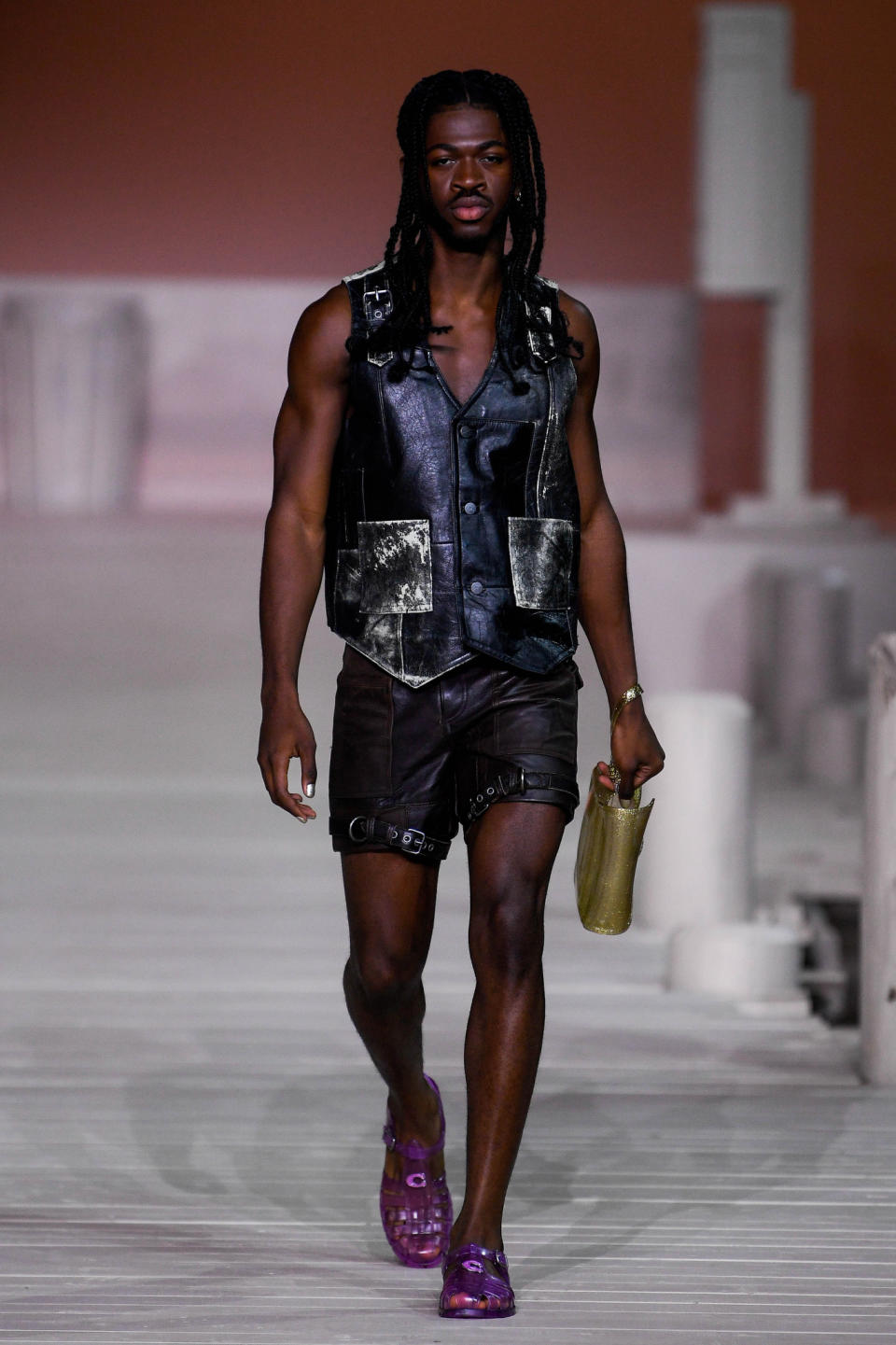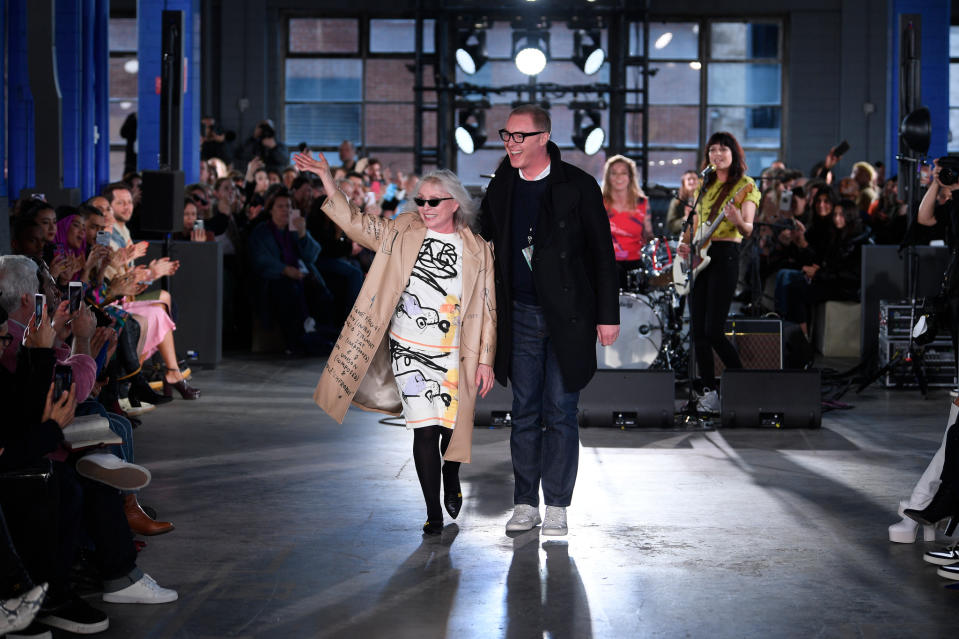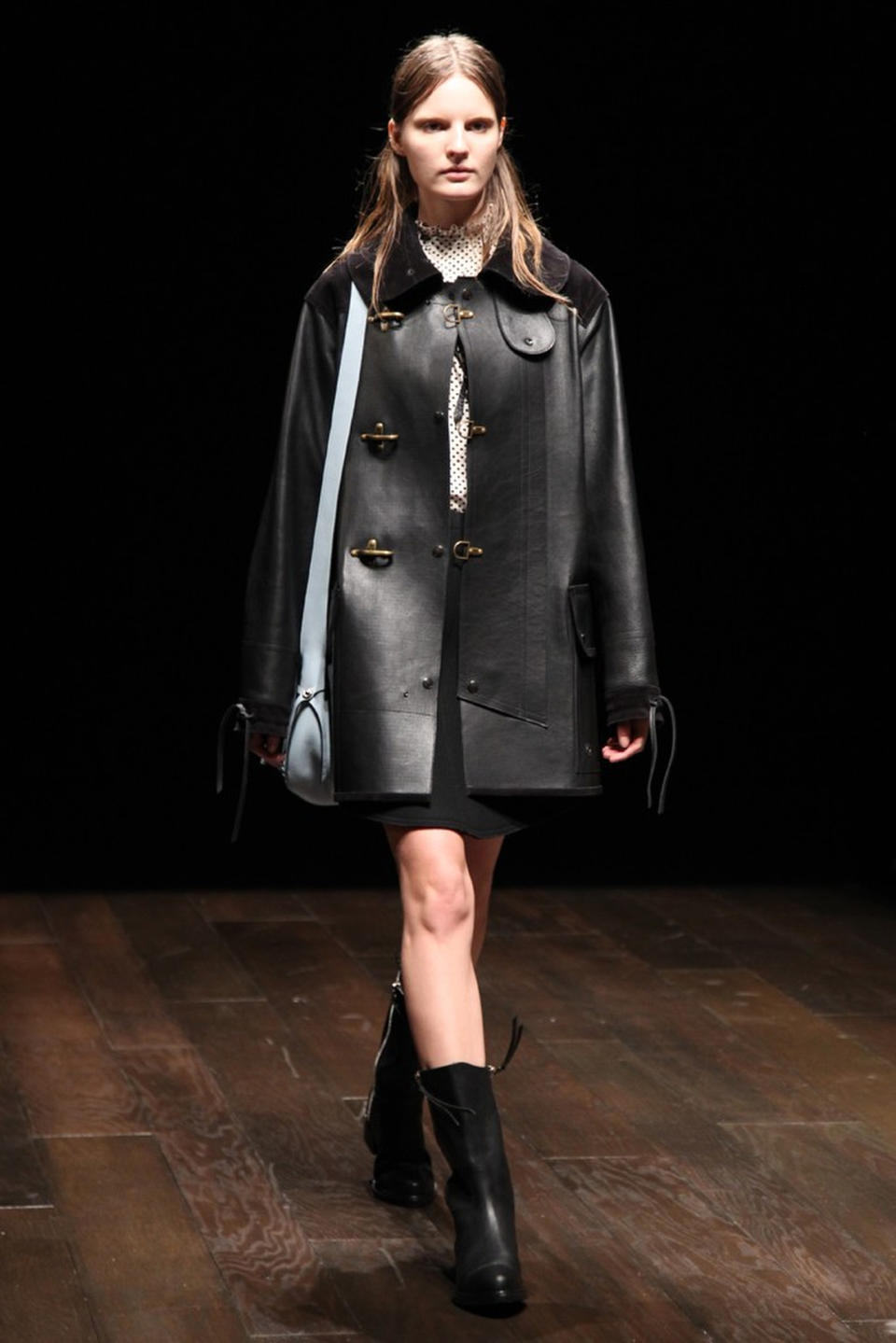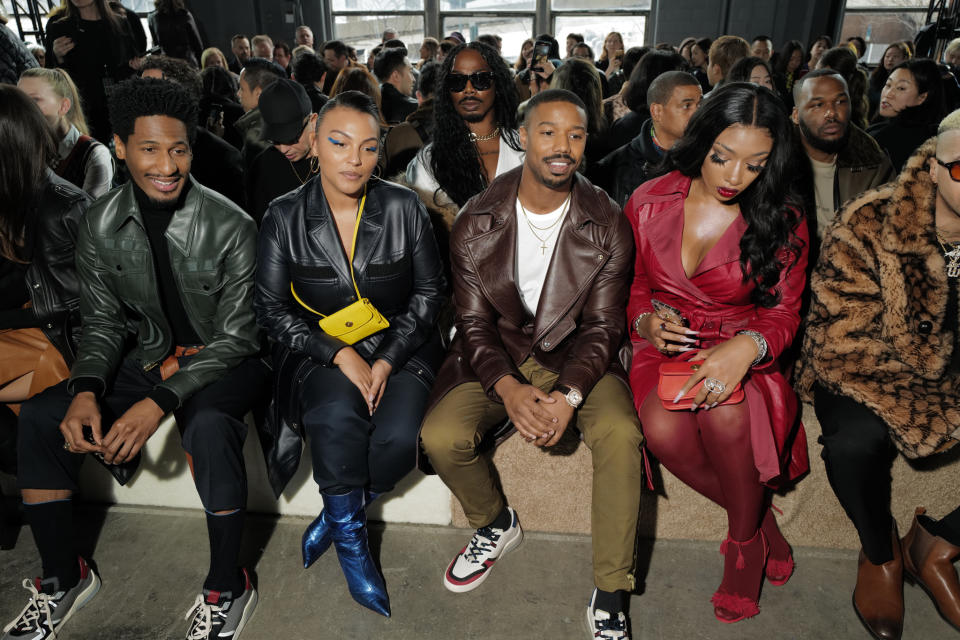Stuart Vevers Celebrates a Decade of Design at Coach

It was in 2013 when Coach Inc. was faced with a tough task — find someone to succeed Reed Krakoff as executive creative director. Krakoff, who is credited with helping to transform the venerable leather goods brand into a new, more fashion-led company during his 16-year tenure, was exiting to focus on his own label, and the search was on.
That search soon led to a young U.K. native with a rich résumé and a career in the accessories field at high-end European brands. His name was Stuart Vevers.
More from WWD
Michael Kors Wins in Social Engagement During New York Fashion Week
For Fall 2024, JW Anderson Embraces the Pragmatic, and the Grotesque

Krakoff’s shoes were undoubtedly big ones to fill, but over the past decade Vevers has proven his worth, turning Coach into a true ready-to-wear player and bringing a fun, yet fashionable twist to the company. Under his watch, the $5 billion brand has mastered the juggling act of balancing creativity and commercialism as it focuses on its new mission to provide “expressive luxury” and sets its sights on attracting a younger customer.
“He’s had a tremendous impact,” said Todd Kahn, chief executive officer of Coach, who has worked with Vevers since he joined. “We were a great accessories brand but we lacked fashion credibility. But Stuart brought us into the fashion conversation — and that wasn’t easy to do for a brand that was already over 60 years old. He made us relevant.”
Kahn said over the past decade, Vevers has “given life” to Coach’s move away from its longtime focus on “affordable luxury” to this new strategy toward self-expression. “It’s been monumental. Stuart and our design and marketing teams are crucial to the storytelling and building the momentum.”

On Thursday night, Coach celebrated Vevers’ 10-year anniversary as its executive creative director with a runway show at the New York Public Library, followed by a star-studded dinner.
Vevers was born in Yorkshire, England, in what he describes as “working class northern English” family, and graduated from the University of Westminster. His first job was at Calvin Klein, followed by Bottega Veneta, Givenchy, Louis Vuitton, Mulberry and Loewe, where he was before Coach tapped him.
“My first job after school was at Calvin Klein,” the 49-year-old designer recalled, prompting him to move to New York. “I’d never been to New York and I missed my graduation. I got offered the job based on an interview that I did in London, and then a project. So I got on a plane and came to New York. I was only here about two years that time — it was the ‘90s, I was 21, and it was fun. But I always felt like I hadn’t quite done New York. In fashion, everyone just kept telling me, ‘You need experience in New York, you need experience in Europe, you need to understand factories.’ And it’s true. So I went from New York to Milan, then Paris, London, Madrid and back to New York.”
Although he was happy at Loewe, he was also intrigued when he was first approached about the Coach job. “I was actually very happy where I was and I was not looking,” he said. “But it was curiosity, because having worked primarily in the world of leather goods, I knew a lot about Coach — probably more than most people would know in Europe, because I was working in that industry. It was this very unique brand — really the only true leather goods brand of scale from the U.S. Every studio I’d worked in had myriad Coach bags in the archive, especially from the ‘60s and ‘70s. So I was curious: What was this brand? What made it tick?”

He was asked to create a project, exploring what he would do to evolve the company, and when he was done, he discovered that he really wanted the job. “I realized that it offered something very, very different to what I’d done before. And I found that really intriguing as an opportunity to learn and grow,” he said.
And he believed that by combining his personal aesthetic and his professional experience, he could bring a fresh point of view to Coach.
Personally, it was his “love of counterculture, pop culture and youth culture” that he believed aligned with Coach’s heritage as an American brand targeting a younger customer. Professionally, he learned at his prior positions the importance of “a brand story, heritage, the strength of codes,” he said. “That was a big part of my training. I also really learned about craft — I spent years in factories with craftspeople and I realized that was part of the magic of fashion — when a great craftsperson and a great designer come together, that’s where the magic can happen.”
While leather goods remain the bulk of Coach’s business — Kahn said apparel still represents under 10 percent of sales — it was Vevers who created the first comprehensive ready-to-wear collection for the company. “We had classifications — key items like trenchcoats — but Stuart created ready-to-wear and had people think differently about Coach. And while it’s still a relatively small business for us, we see so much upside.”
For Vevers, expanding the apparel offering was always part of his plan. “My vision for Coach is a world that includes everyone, where belonging and individuality play side by side with heritage and pop culture to build on the unique legacy of American style. So it was really important to build a world for the Coach guy and girl, discover who they were and what excited them. And a very important part of that was to offer a full look, something that Coach had not done before, and that gave me an opportunity to reset.”
Part of that reset was to bring Coach front and center during New York Fashion Week. “In some ways it was very daunting, because people are very quick to jump on that, like: ‘Who do you think you are?’” he said. “But at the same time, it also gave me an opportunity to start a new chapter and there was something very magical about that.”

His first presentation for fall 2014 featured a tight collection of 18 women’s pieces, some of which have become staples of the brand, such as shearling coats, varsity jackets and sweaters, many with workwear influences. “People felt it was believable,” he said, “and it created some momentum for me at Coach.”
Today, Coach’s shows are among the most extravagant during fashion week, with celebrities on the catwalk and in the front row and large crowds clamoring for seats. But the success is not really surprising to Vevers. “I had a lot of ambition and felt Coach deserved a place in fashion and American style — it has the legacy, it has the story, it has the client.”
In recent years, that client has become younger. “We’re not firing our older customer, but we’re engaging a younger customer,” Kahn said. “Fashion always looks to the younger generation to reinterpret opportunities, and our Gen Z and Millennial customers are the future of fashion. But we’re also cognizant that we’re a large brand, so we do both.”
Vevers agrees: “My natural instinct is always to look to the next generation for inspiration, for direction. I try to listen carefully to what I’m hearing from the next generation, because in the end, that next generation influences all of us. Sometimes those first things you hear or see can be a little scary because you’re not used to them. But I think it’s really important and it’s natural that the collection would be more youthful. But I still want it to appeal to a broader audience.”
Looking back at the past decade, Vevers said he’s perhaps most proud that “Coach has now been transformed into a full fashion world that really stands for the freedom to express yourself.” As with any transformation, there are some things that worked and others that didn’t. But Vevers is OK with that.
“Both of those things are tied up with taking a risk,” he said. “And I think it’s really important as a designer to push the boundaries to see where you can go. Sometimes that works and sometimes it doesn’t. But if you don’t take those risks, you’re never going to realize the potential. Introducing ready-to-wear was huge and for it to be successful and accepted and for it to find a real client was a big achievement. Coach will always be known most for its bags, but the fact that it’s now also known for a shearling coat, or a fun intarsia sweater is something I’m really proud of.”
He admits that there are some things that haven’t worked over the years including his early addition of the Coach “C” pattern to its collections. “I tried to introduce it here and there but it wouldn’t stick,” he said. “It wasn’t until I put it on the runway for the collection where we collaborated with the Keith Haring Foundation that people accepted it again and it became a big part of [what we do].”
He also acknowledges that sometimes Coach can get too “fantastical” and can lose touch with reality. “Coach is grounded and rooted in something quite real and you’ve got to keep trying to be creative but sometimes when I look back, I think maybe we went too fantastical. But fashion is quite forgiving.”
Philosophically, he believes that “confidence and fear are part of the journey of a designer.” And the fact that’s he’s had a lot more wins than losses over the past 10 years proves he’s found the right formula.
“It gives me even more reason to stick with the things I believe in and follow the convictions I have about fashion — whether it’s sustainability, diversity on and off the runway, gender representation. It absolutely gives me the confidence to push those things forward. And it gives me confidence to believe in my aesthetic and the things I love — this clash of heritage and pop culture.”

Navigating the pandemic also presented a dilemma, he said. At the time, there was a lot of conversation that “fashion should go quiet for a while because people had much more important things to think about in their lives. But after thinking about it a lot, I decided, actually no, I don’t think we should hibernate, I felt like we had to find our relevance in this rapidly changing world. So with the team, we decided to keep creating collections and finding ways to present them, which was a huge challenge. But I think it brought something very different out of me and the team.”
It led to what Vevers referred to as “a really big pivot,” with a renewed focus on sustainability “because I just personally, in that moment, felt like I needed to do more to change the way I worked.”
It also led to the creation of Coachtopia, a circular collection of recycled, repurposed or renewable bags, apparel and footwear that launched earlier this year. “We really put a stake in the ground,” he said, adding that this new brand proved the company’s ability to evolve the way it produces its lines. “Sometimes it’s difficult to change a whole system, but we realized with Coachtopia that we can do something completely different. The response has been phenomenal, so it shows that people are very interested in this. And its influence on the rest of Coach is going to be, I think, a big one.”
In addition to the sustainability focus, the collections became more gender fluid during the pandemic, and Coach presented the line through a series of images rather than a big runway show.
Overall, Vevers said he “returned to what I always loved about fashion — the fact that it brings joy and it still had a relevance in people’s lives. They wanted something to make them smile, to make them feel good. And fashion has the power to do that. So that was a really important moment.”
Another important moment came last month when Coach’s parent, Tapestry Inc., revealed that it was buying Capri Holdings, which owns Michael Kors, Jimmy Choo and Versace, in an $8.5 billion deal. At the time, Wall Street singled out the success Tapestry has had with Coach as the key catalyst for the deal. And no doubt, Vevers is a key part of that picture.
Kahn said there are no plans at this point to tap Vevers to work on Tapestry’s other brands — the company also owns Kate Spade and Stuart Weitzman — but “it’s hard to say what the future will hold.” He said after the deal closes, the company will undoubtedly take what it learned from Coach and “bring it to the brands we acquire.”
“We want to create a brand world at Tapestry,” he continued, but with each one “focused on their own DNA. “That’s where the opportunities are. We can’t ‘Coachify’ the other brands and both Stuart and I have full-time jobs. So we’ll be celebrating Stuart’s 10th anniversary and continue to focus on delivering growth opportunities in a variety of categories and geographies. This is a $5 billion brand with a tremendous upside.”
So with so many designers changing jobs at top houses around the world, does Vevers see himself staying at Coach for another decade?
“It’s not an easy thing to talk about, but I feel extremely inspired, very engaged,” he said. “I love the Coach brand. I feel like we’re trying new things all the time. We’re always pushing the boundaries of what we can be. If you can wake up in the morning and you’re excited to come to the studio and start creating, that’s all that matters. It’s been a good fit and I’m proud to be the executive creative director of Coach.”
Best of WWD


